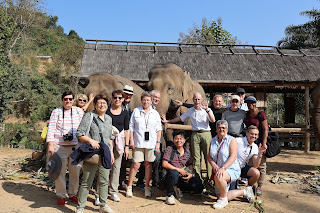Established in 2001, Elephant Village has been supporting indigenous people in
remote areas by giving them employment through the creation of jobs under fair
social circumstances.
Elephant Village ensures the support and the survival of elephants living in
harmony with nature and the community. They are kept away from abusive work
and cared by professional veterinarians.
Elephant village ensures the preservation of a pristine river valley that
otherwise would be destroyed by signing a multi-year lease agreement with the
Lao government to establish a sustainable tourism project.
|
Entrance to Elephant Village.
The Elephant Village was founded in October of 2003 after intense
preparations that included the mapping and creating of a special
elephant trail to the Tad Sae Waterfall.
|
|
Elephant Village Map.
Behind the Elephant Village, Mr. Peschke came across temple ruins. He
discovered that these bricks were once part of a settlement known as
Baan Xang (Elephant Village).
-
According to local sources, this village was established in the 1890’s
for the capture, training and care of royal services elephants of
Luang Prabang the capital of Lane Xang Kingdom.
|
|
Receiving instructions on the Elephant Village activity.
Elephant Village’s mission is to provide a peaceful home and sustainable
future for elephants in Laos. Tourism activities contribute to the
elephants giving them the opportunity to support themselves and
neighboring local villages.
-
Elephant Village is managed in a sustainable and fair manner that
actively benefits both elephants and local villages.
-
Most of the camp staff come from nearby villages. Supplemental
elephant food is purchased from villages around the camp.
|
|
The elephants.
There have been a few efforts towards releasing elephants into the wild
in Thailand with little success. Domesticated elephants are no longer
naturalised to life in the jungle and there is little ‘wild’ left in
them. Thus, releasing elephants into the wild doesn’t appear to be a
viable alternative.
-
These former logging elephants face a bleak future because they will
find themselves on the margin of urban environments with no chance of
finding adequate food or water and no access to veterinary care. Some
say many of the soon-to-be jobless elephants may even be killed, or
abandoned to a slow starvation.
|
|
The elephant keepers.
A mahout is an elephant rider, trainer, or keeper.
-
Mahouts were used since antiquity for both civilian and military use.
-
Traditionally, mahouts came from ethnic groups with generations of
elephant keeping experience, with a mahout retaining his elephant
throughout its working life or service years.
-
See more at
Mahout - Wikipedia.
|
|
Learning basic elephant commands.
The verbal commands given to the elephants by the mahouts are all in
Sinhala, one of the two official languages of Sri Lanka.
-
The Thai words for the six main commands are: melong (lie
down); hao (stop); khwa (turn right); sai (turn
left); toy (reverse); pai (go).
|
|
Feeding the elephants.
Elephants are herbivorous and will eat leaves, twigs, fruit, bark,
grass, and roots. African elephants mostly browse, while Asian elephants
mainly graze.
-
They can eat as much as 300 kg (660 lb) of food and drink 40 L (11 US
gal) of water in a day.
-
Elephants have morning, afternoon, and nighttime feeding sessions.
-
At midday, elephants rest under trees and may doze off while standing.
Sleeping occurs at night while the animal is lying down. Elephants
average 3–4 hours of sleep per day.
-
See more at
Elephant: Behaviour and ecology - Wikipedia.
|
|
Wrestling with two elephants.
Constant exercise is critical to elephants’ health: typically, they walk
up to 64 km (40 mi) a day.
-
Captive-held elephants usually are confined in small enclosures on
hard surfaces in cold climates, all of which cause them a wide variety
of physical and emotional problems.
-
Elephants born and raised in zoos live less than half as long as those
living in their native Africa and Asia, despite being protected from
predators and having better care.
-
Many of the deaths are thought to be linked to obesity, because the
animals are well fed but get very little exercise in their small
enclosures.
|
|
All visitors offer to exercise the elephants!
|
|
Trying to lift both elephants at the same time.
It was impossible!
|
|
Eric Bouteloup and the local guide Lam pose for posterity.
|
|
The entire group poses for posterity.
|
|
Elephant Hospital.
Elephant Village have access to a professional veterinarian to provide
care for the elephants and training for staff and mahouts, ensuring that
the elephants receive ongoing, high-quality medical attention.
|
|
Dung Paper Making.
Once the dung has been collected, it's boiled with margosa leaves, a
natural disinfectant. After this sterilisation it's mixed with recycled
paper to produce a smoother surface.
-
There's around 30% dung and 70% recycled paper in all the products
they create for us, making it a 100% natural material.
|
|
Elephant Museum.
To see the many items and artifacts they have collected for us to
discover and learn about.
|
|
Physical differences between African and Asian elephants.
There are more than 10 physical characteristics that differentiate Asian
and African elephants.
-
For example, Asian elephants' ears are smaller compared to the large
fan-shaped ears of the African species.
-
Only some male Asian elephants have tusks, while both male and female
African elephants grow tusks.
-
An Asian elephant has one “finger” at the tip of its trunk, a head
with two humps at the top, a back that is rounded or arched, and four
toenails on each back foot.
-
African elephants also have skin that is looser and looks more
wrinkled than Asian elephants do.
-
See more at
Physical Differences Between African and Asian Elephants -
Wikipedia.
|
|
Leaving Elephant Village.
|
See also
Source
Location

































































